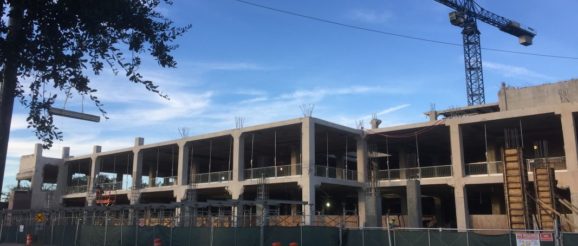Gentrification A Big Concern For Some, As Houston Builds Its Innovation District – Houston Public Media

About three years ago, city leaders began a push to make Houston more competitive in the world of high-tech innovation.
One thing they did was start what they call an “innovation district” in Midtown in what had been an old Sears store.
Called the “Ion”, it will be the center of Houston’s future innovation district and it’s meant to help connect startups and entrepreneurs with resources, investors and large corporations.
It’ll be part of a four-mile “innovation corridor” that runs roughly along Main Street from downtown to the Medical Center.
But not everyone is excited about the project.
To embed this piece of audio in your site, please use this code:
“It will push African Americans out of a community that they have invested in for years,” said Carl Davis, chair of Houston Society for Change.
It’s one of four groups that founded the “Houston Coalition for Equitable Development without Displacement.” They’ve held community meetings with stakeholders to voice their concerns about the Ion and also figure out what needs to be done for the development to benefit the community.
“We’re also looking at the opportunities that the Ion will bring, whether that will have job opportunities for people of color, whether that will have affordable housing for people of color, whether there be those services that we need to sustain ourselves,” Davis said.
They want the developer of the Ion, Rice Management Co., to sign a Community Benefits Agreement. It asks for affordable housing to be developed, support of minority-owned businesses, hiring of minorities for the construction and inclusion of entrepreneurs from the community at the Ion.
“If we’re a community that they sit next to and will be affected by that,” Davis said, “why don’t we at the table enjoy some of those benefits?”
Ryan LaVasseur, managing director at Rice Management Co., said he’s talked with Davis and others about the issue and that he’s open to dialogue, including a Community Benefits Agreement that could meet some of the demands – like hiring people from the community.
“We’re going to look into different practices for hiring and different policies,” he said. “And we want to best understand what it is that the community wants and we want to find the right people that can execute on this work.”
Gaby Rowe, the executive director of the Ion, said she is concerned with making sure minorities and members of the surrounding community will benefit from the innovation district.
“As we develop that innovation opportunity,” she said, “what do we need to have in terms of programming to make sure that the small businesses in the community, the young people coming up in school and out of school have the skills necessary to be able to take advantage of those innovation opportunities?”
When it comes to affordable housing in Midtown and Third Ward, the city’s housing department says they’ve been working on it.
Ray Miller, assistant director at the Housing and Community Development Department, said there are already two affordable housing complexes right by the future Ion development along Main Street next to the Southwest Freeway – with a third parcel intended for the same purpose.
And, he said, the housing department is using a $350 million federal grant for Hurricane Harvey recovery for affordable housing.
“The initiative at the city is to take some of the public dollars that we have to offset some of the rising costs and the rising trends,” Miller said. “And place affordable housing options in those areas that we’re seeing gentrification and seeing other households getting pushed out because of the rising rents.”
Another concern is businesses in the area, some of which may have to eventually make way for the development.
Besides a Fiesta market, a Shipley’s and a Jack in the Box, a daycare center is on Rice property and included in the innovation district master plan. LaVasseur said he hopes to keep the Fiesta or another grocery store there.
Some business owners in the area welcome the development.
“I imagine a lot of young professionals to be using the facility,” Spot Clark, who owns a barber shop just north of the future Ion, said. “I think it’s going to attract some great people to this area that will enjoy the services that we offer here at the barber shop.”
But Carl Davis is concerned with the ripple effect gentrification could bring to the broader community.
He said he would be more confident in the future only when the developers of the Ion sign that Community Benefits Agreement, which they say may happen toward the end of the process.
But until then, Davis said, it’s “more talk than action.”
